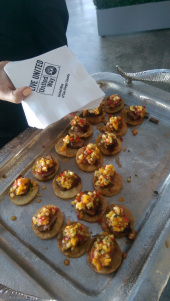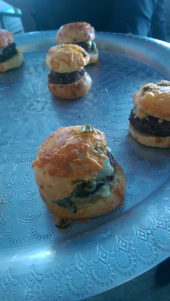I have failed the CalFresh Challenge. As you may recall from one of our recent blog posts, the San Diego Hunger Coalition recently invited us to try living on a food budget of $4.38 per day, the amount allotted to those living on CalFresh (food stamps).
This anti-hunger initiative, called the CalFresh Challenge, was designed to raise awareness for the food insecure across the state, inviting us to walk a mile in their shoes, so to speak.
After trying the challenge myself, I can definitively say: My knees hurt, and my feet are sore. These individuals face an immense day-to-day struggle, and it was impossible for me to make that budget work for myself and my family, even just for a short period of time.
When I first signed up, I truly believed I was ready to go. I was going to conquer this challenge!
In my family, we already have a set food budget, we meal plan, three of the four of us take packed lunches, and I personally love leftovers and have no problem eating the same thing every day. I assumed I would change our menu to reflect a lower weekly cost—all in all we spend about $150.00 in groceries a week, not too far off from the $122.64 per week for the challenge (calculated at $4.38 x 4 people for the week).
But my major failing occurred when I made a last minute trip out of town even though I knew I would be getting back late before the start of the week. My planning suffered.
On Monday, I realized it was the 21st, the first day of the CalFresh challenge. Uh-oh. “Well, I can pick up on Day 2,” I thought. Day 2 came and went, and soon it was Day 4 and I still hadn’t found the groove I anticipated.
It doesn’t seem overbearingly difficult in theory, but one meeting leads to a new task at work, the kids need to be picked up at school, you have a date night planned, work runs late, and now the week is over. In our fast-paced lives, one day becomes seven in a flash.
Because we, as a family, can buy in bulk, it doesn’t eat up the entire budget for the month, and we are OK. For the food insecure, though, this is not the case. They don’t have this luxury, and in reflection, I’m not sure how we could cope without it.
The second thought I had concerned the abundance of food I am surrounded by daily. There are days where I do not have to bring a lunch or worry about breakfast. At a morning meeting, coffee and continental breakfast is provided, then at the 10 a.m. meeting I get snack bars, fruit, and more coffee. Then there’s a lunchtime meeting – lunch is served, and if another group in our building had a lunchtime meeting, there will be leftovers…you get the idea.
Again, this is not the reality for the target population in this challenge. For many of those living on food stamps, there are no catered meetings and no free meals. Sitting back and really thinking about the amount of food in my life in turn made me comprehend the scarcity of it for others.
Living on this budget, even just for a week, proved difficult, and that’s without trying to keep the diet healthy. If you want nutrition, the mountain’s slope becomes even steeper.
In the end, I was looking forward to the challenge, but I simply didn’t prepare. This caused me to completely fail the challenge, something that makes me wonder: If a family is already strapped for money to cover food expenses and they do have a busy week, how much extra stress is that adding to the many stresses of living in a poor community? What about the stress of traveling to get to one or two jobs? How do you even quantify the impact this has on their health? How do they, then, have time to plan?
As we continue improving the lives of this population, I look forward to seeing and supporting the work being done in San Diego that will not only reduce the number of children with hungry bellies but also deliver nutrient-dense local food to the community in need.
While the challenge has ended, I highly recommend you keep a food budget of $4.38 per day in mind as you go through your weekly routine. Think about it when you’re grabbing lunch, snagging a latte, or sitting down to a nice dinner with your family.
Let me know what you learn and experience as you contextualize your current eating habits this way. I think you’ll be surprised and moved by what you learn—I know I was.
– Michele Silverthorn, Program Officer, Alliance Healthcare Foundation. To read their blog, please click here.


























